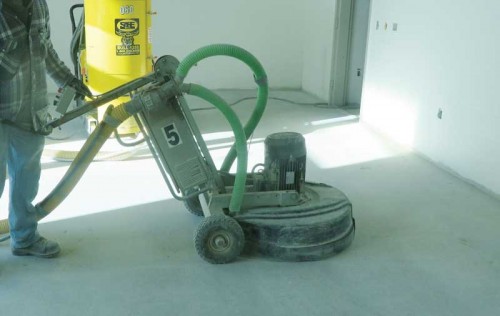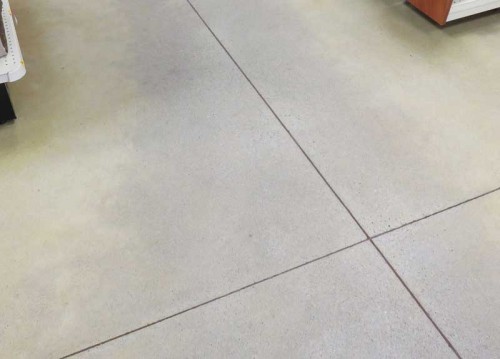Producing quality polished concrete floor slabs

Project team members and responsibilities
Projects including polished concrete floor construction will generally, but not necessarily, involve a combination of some or all of the following project team members.
Owner
Owners, who may employ a project manager to administer the project, should be responsible for the selection of the aggregate exposure classifications and finished gloss. They should also establish their level of expectation regarding acceptable minimum esthetic quality and uniformity within a given financial budget. However, owners should be aware there is a higher price to pay for the achievement of uniformity and high esthetic surface quality.
Owner’s representative
The owner’s representative, typically an architectural or engineering firm acting as the prime consultant, is primarily responsible for advising the owner on factors affecting the achievement of the selected classifications. This entity should also communicate the client’s expectations to the project team and state the importance of considering the factors affecting the classifications. For example, installation of building interior partition walls before the polished concrete operations could reduce the ability to achieve an optimal level of flatness essential for uniform results when the concrete is polished.
It is also important the prime consultant provide information to the concrete supplier to ensure compliance with CSA A23.1-09 (R2014), Concrete Materials and Methods of Concrete Construction and the achievment of special performance requirements of the concrete. (CSA A23.1-09 (R2014), Concrete Materials and Methods of Concrete Construction requires the owner—or by default the prime consultant—to specify the owner’s performance criteria for architectural and other property requirements).
Specifier
The specifier, generally retained or employed by the owner’s representative, will typically require a particular type of polished concrete system be applied by an approved polished concrete contractor—although, sometimes a polished concrete contractor will be specified. It should be the specifier’s responsibility to communicate key requirements within the project specifications to all bidders, and especially those substrades whose operations can influence achievement of an acceptable level of performance. It is essential the specifier is aware of what those requirements are—including the practices influencing flatness and uniformity of the constructed slab’s near-surface properties.
In this author’s opinion, the specifier should have the concrete supplied in accordance with the performance method of specification, but with some qualifications such as stipulating that supplementary cementing materials should not be used.
General contractor
General contractors (GCs) or construction managers (CMs) will often purchase the concrete. They will also typically sub-contract or issue trade packages for subgrade construction and concrete placement and finishing. In addition to managing the project, they may be responsible for some other specific requirements, such as curing procedures and the provision of ancillary protection requirements. Under CSA A23.1-09 (R2014) Concrete Materials and Methods of Concrete Construction / Test Methods and Standard Practices for Concrete for performance specifications, the contractor is responsible for working with the concrete supplier to meet performance criteria for both the plastic and hardened concrete.
To ensure the true costs of producing a polished concrete slab are understood during the bidding processes, it is important the GC or CM realistically understands any implications the specifications can have on mix design parameters. Bidders should also be informed of any additional procedures not typically needed for conventional concrete slab placement and finishing. The GC or CM should administer the various sub-trades using the floor before and after it is polished so permanent defects are not caused during work. Further, it is important the GC or CM include for the cost of any procedures and materials required should rapid drying conditions prevail at the time of concrete placement and finishing—unless this task has specifically been given to the concrete floor contractor.

Supplier
Concrete suppliers are responsible for producing and supplying concrete using a mix design formulated to satisfy the requirements of CSA A23.1-09 (R2014). They are also required to certify their concrete will comply with the specified performance criteria. In this author’s opinion, prior to providing a quotation during the bidding process, the concrete supplier needs to be informed supplementary materials should not be used. The reasoning behind this decision should also be communicated.
Concrete floor contractor
The concrete floor contractor (CFC), who generally sub-contracts to the GC or works under a CM trade package, may also provide polished concrete applications, although this is rare. The CFC’s responsibilities should include identifying additional procedures and processes required by the specifications for placing and finishing the concrete. This is important so an acceptable esthetic and uniform quality surface finish can be achieved by the polished concrete contractor. To avoid potential conflict, these additional procedures and processes need to be costed and included in the CFC’s bid for the work.
Polished concrete contractor
The polished concrete contractor (PCC), who may also be the CFC, but is typically a specialist flooring company that applies toppings or coatings, should be responsible for producing the specified aggregate exposure and finished gloss requirements. The PCC should ensure all critical factors influencing the specific work, but outside of its control, are understood by all project team members.
Manufacturer or supplier
The polished concrete system manufacturer or supplier, who provide the densifiers, dyes, stains, and sealers comprising a particular system, should be responsible for educating team members on the important factors considered for optimal use of its products.







